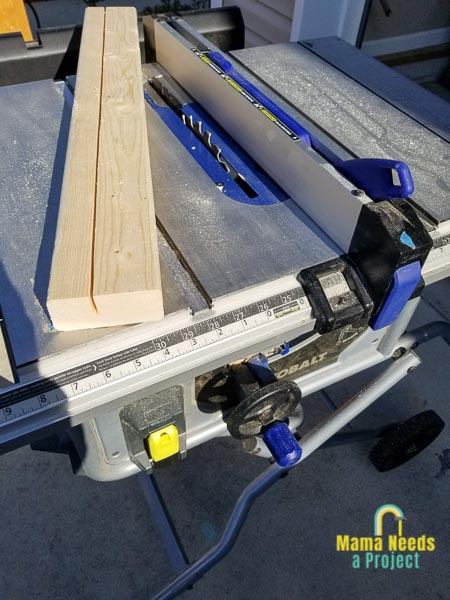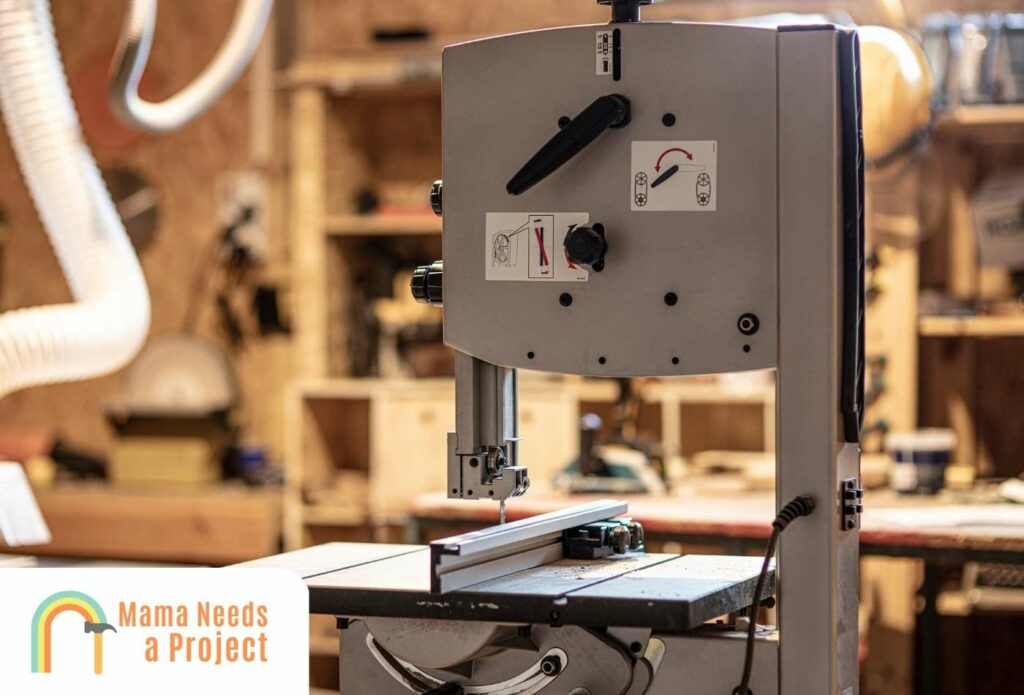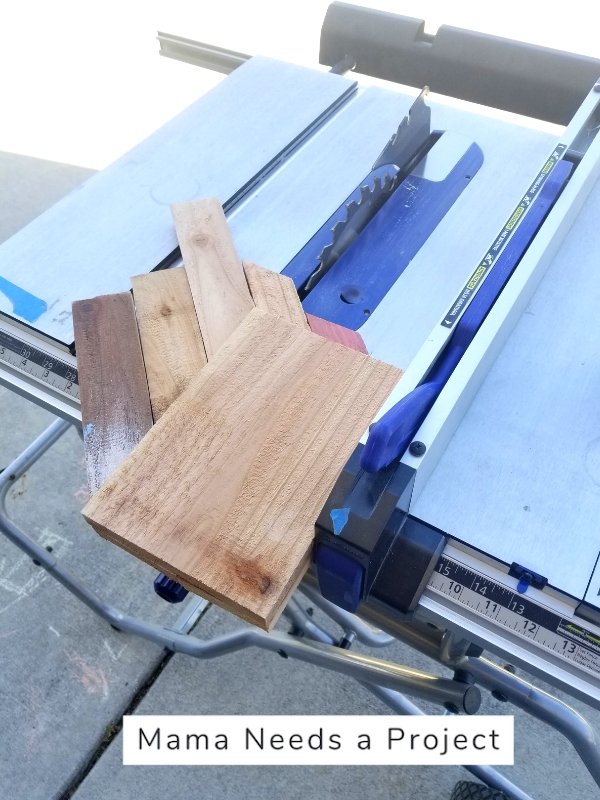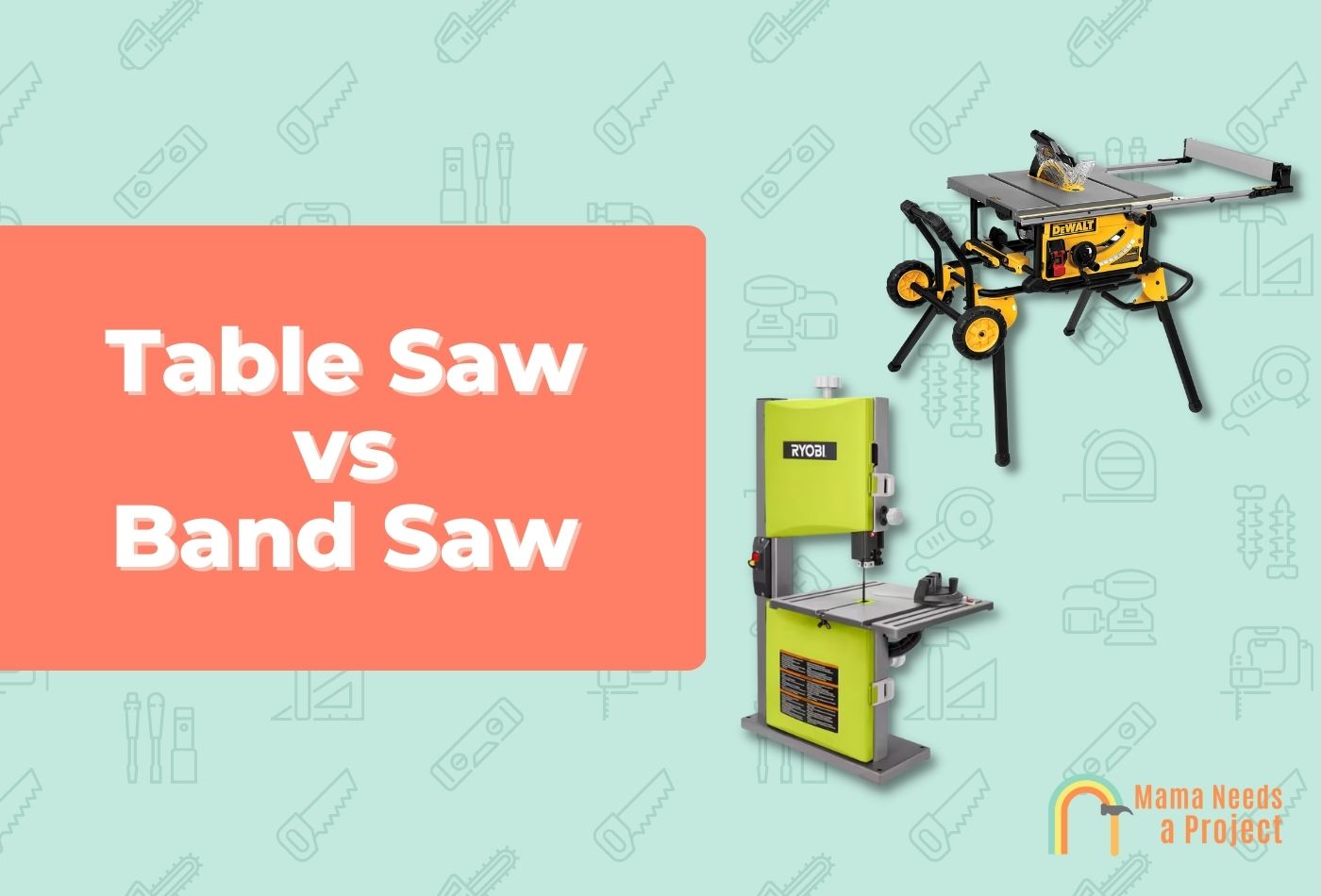Table Saw vs Band Saw: Which Should You Use? (Ultimate Guide)
Table saws and band saws are two common types of saws that woodworkers use all of the time. But what are the differences and when should you use each one?
In this post, I’ll compare the difference between table saws vs band saws so you can know when to use each one. Let’s dig in!
The key differences between a table saw and band saw include:
- While both tools are valuable in a workshop, table saws are better suited for projects that require a high level of precision and consistency, while band saws excel in handling more complex cutting patterns and resawing tasks.
- A table saw’s circular blade and adjustable fence allow for accurate, repeatable cuts, whereas the band saw’s continuous loop blade provides more flexibility in cutting intricate shapes.
What is a Table Saw

A table saw is a powerful tool with a flat table-like surface and a circular saw blade that protrudes through an opening in the table.
This setup allows you to slide your wood across the table and make precise cuts with ease.
The blade’s height and angle can be adjusted, which means you can make all sorts of cuts, from simple straight cuts to more complex angled and beveled cuts.
Now, table saws come in a variety of sizes and styles, but they all have a few key components: the saw blade, the table surface, a fence, and a miter gauge.
The fence is a straight edge that you can adjust to guide your wood as you make those nice, straight cuts.
The miter gauge is a handy little tool that helps you make angled cuts, like when you’re creating picture frames or cutting crown molding.
Safety is always a top priority when using any power tool, and table saws are no exception. While some table saws have more advanced safety features that can stop the blade from spinning when detecting a finger, older, less advanced models can be extremely dangerous if you aren’t careful.
Pros
- Can make a wide range of cuts on both hard and soft woods
- Extremely accurate thanks to their adjustable fence and miter gauge
- Can make cuts quickly and efficiently because of their powerful motor
Cons
- Table saws are usually more expensive, much louder, and can require more space in your workshop
- Can be more dangerous if not used properly
If you’re a beginner just getting started with woodworking, check out these amazing beginner table saws that are easy to use and get the job done!
Check out this miter saw vs table saw comparison for more info on which is better for your next project!
What is a Band Saw

A band saw is a unique, versatile power tool that has a continuous loop, or band, of saw blade that’s wrapped around two large wheels.
This setup allows the blade to cut smoothly through your wood as you guide it along the table surface. One of the coolest things about a band saw is its ability to make both straight and curved cuts, opening up a world of possibilities for your projects.
Band saws come in various sizes, with different throat capacities (the distance between the blade and the saw’s frame) and table surfaces. You’ll find that most band saws have a few key components: the saw blade, the table surface, a fence, and a miter gauge. The fence helps you make straight cuts, while the miter gauge can assist you in making angled cuts.
Pros
- Can make curved cuts that other saws can’t
- Great for resawing and cutting thin slices of wood
- Much quieter than other types of saws
Cons
- Can’t complete as many types of cuts
- Can be more difficult to control and produce accurate cuts because of blade drift
Looking to buy a table saw? Check out the best table saws under $1000 for more help finding the best one for your needs!
Differences Between a Table Saw and Band Saw
Table Saw vs Band Saw: Type of Cuts
One of the key differences between a table saw and band saw is the type of cuts they can make.
When it comes to table saws, they’re the go-to choice for precise straight cuts. They’re perfect for making rip cuts (cutting along the wood’s grain), crosscuts (cutting across the grain), miter cuts (angled cuts across the width of your material), and bevel cuts (angled cuts through the thickness of your material).
On the other hand, band saws bring a whole new world of cutting possibilities to your workshop!.
Not only can they make straight cuts like their table saw buddies, but they can also make beautiful curved cuts and intricate shapes. Their continuous loop blade allows you to navigate tight corners and create unique designs with ease.
Band saws are also great for resawing – or cutting your wood into thinner slices.
Table Saw vs Band Saw: Precision
Table saws are renowned for their ability to make precise straight cuts with a high degree of accuracy – which is why so many woodworkers (including myself) love them.
The table saw’s fence, which acts as a guide for the material being cut, is adjustable, allowing for consistent and repeatable cuts. This means that whether you’re making rip cuts, crosscuts, or even more complex miter and bevel cuts, a table saw will ensure a high level of precision.
Additionally, the circular blade of a table saw rotates at high speeds, providing clean and crisp edges on the material being cut.
For projects that require exact measurements, tight tolerances, or precise joinery, a table saw is often the preferred choice.
In contrast, band saws offer more versatility in the types of cuts that can be made, including both straight and curved cuts.
While band saws can also produce precise cuts, they typically require more skill and practice to achieve the same level of accuracy as a table saw, especially when it comes to straight cuts.
The continuous loop blade of a band saw can be subject to blade drift, which occurs when the blade veers off course during a cut. This can make achieving accurate cuts more challenging and may require additional setup and adjustments
Table Saw vs Band Saw: Size
Whether you’re working in a spacious shop or a cozy corner of your garage, it’s essential to know how these tools will fit into your creative space.
First, let’s talk table saws.
These handy helpers come in a variety of sizes, from compact benchtop models to larger contractor and cabinet-style saws.
Benchtop table saws are perfect for those with limited space, as they can be easily stored when not in use and set up on a sturdy workbench when needed. However, keep in mind that their smaller size might limit the size of the material you can work with.
On the other hand, contractor and cabinet-style table saws are more substantial, offering greater stability, rip capacity, and precision – but they can take up a significant amount of floor space.
Don’t forget to account for the additional room needed for infeed and outfeed support when working with larger pieces!
Now, let’s move on to band saws.
Just like table saws, band saws come in various sizes, with the main difference being the throat capacity (the distance between the blade and the frame of the saw).
Benchtop band saws, with their smaller throat capacities, are a great space-saving option and can handle many common woodworking tasks. However, if you need to cut larger workpieces or plan on resawing, you might want to consider a floor-standing band saw with a larger throat capacity.
The height of a band saw can also vary, but it generally takes up less floor space than a table saw, making it a bit more manageable for those with a smaller workshop.
In the market for a band saw? Check out these budget band saws that work amazing!
Table Saw vs Band Saw: Noise
When comparing a table saw vs band saw in terms of noise and how loud they are – there’s a pretty big difference.
Table saws are known for their ability to make quick, precise cuts, but they do have a bit of a reputation for being on the louder side. The noise primarily comes from the powerful motor and the high-speed rotation of the circular blade. Depending on the model and the type of material you’re cutting, table saws can produce noise levels ranging from around 85 to over 100 decibels.
If you’re working in a shared or residential space, the noise produced by a table saw might be a consideration to keep in mind.
Here’s a video that shows how much noise a table saw can produce!
When it comes to band saws, the continuous loop blade and slower cutting speed of a band saw contribute to the reduced noise levels, which usually range from about 75 to 95 decibels, depending on the model and the material being cut.
The video below shows how different model band saws produce different amounts of noise.
Safety Features
Table saws often come equipped with several safety features.
Riving knives, for example, are designed to prevent material from pinching the back of the blade and causing kickback.
Blade guards shield users from direct contact with the blade while also helping to contain dust and debris.
Additionally, many modern table saws incorporate advanced safety technologies, such as flesh-sensing technology that can stop the blade within milliseconds of detecting contact with the user’s skin.
On the other hand, band saws are generally considered to be safer than table saws due to their continuous loop blade design and slower cutting speeds.
The risk of kickback is significantly reduced with a band saw, as the downward cutting motion of the blade helps to keep the workpiece securely on the table.
When to Use a Table Saw

So, when should you use a table saw?
If you need precise cutting – using a table saw is the obvious choice. Because table saws are more precise than a band saw, you can get an accurate cut on a variety of projects.
Whether you’re building custom furniture, like bookshelves or cabinets, or tackling smaller projects like picture frames and decorative boxes, a table saw is perfect for making those precise straight cuts.
Additionally, if you’re working on projects that require accurate joinery, such as shelves with dadoes or rabbets, a table saw will be your go-to tool for creating those clean, precise grooves.
When to Use a Band Saw
So, when should you use a band saw?
If you’re cutting curves or irregular shapes – using a band saw is the way to go.
Additionally, if you’re looking to resaw lumber or make veneers, a band saw has got you covered with its excellent resawing capabilities.
FAQs
Is a band saw better than a table saw?
A band saw is only better than a table saw if you need to cut curves. Both tools excel in different areas, with table saws being ideal for precise straight cuts, and band saws offering versatility for curved cuts and resawing tasks.
Can a bandsaw replace a table saw?
While a band saw offers versatility and can handle a variety of cutting tasks, it cannot entirely replace a table saw. Table saws excel in precision and consistency for straight cuts, making them ideal for tasks that require a high level of accuracy. Although a band saw can make straight cuts, it typically doesn’t achieve the same level of precision as a table saw, so having both tools in your workshop is beneficial for tackling different types of projects.
Final Thoughts
In the end, both woodworking tools can be extremely helpful in your shop for a wide range of projects. Between miter saws, circular saws, and jig saws, there’s no shortage of options when it comes to power saws.
If you need to make precise angled cuts, a table saw is the right choice. However, if you need to make intricate cuts or other irregular shapes, using a band saw is the way to go.
The power saws are similar in that they’re both great tools to cut wood and get the job done quickly and efficiently.

